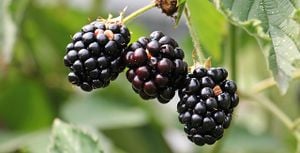| Line 26: | Line 26: | ||
==Aspect== | ==Aspect== | ||
==Exposure== | ==Exposure== | ||
Prefers a sheltered site.<ref name=seymour2014>Seymour, M (2014). [https://www.worldcat.org/title/new-self-sufficient-gardener/oclc/972683557?referer=br&ht=edition The New Self-Sufficient Gardener: The complete illustrated guide to planning, growing, storing and preserving your own garden produce.] Dorling Kindersley. ISBN 9781409346784.</ref> | |||
==Propagation== | ==Propagation== | ||
'''From Seed''': Seed requires warm and cold stratification (see Seed Stratification{{w|Stratification (seeds)}}). E.g. keep seed in a box of sand at warm room temperature for 3 months, then store at 4°c (40°F) for a further 3 months.<ref name=seymour2014 /> | '''From Seed''': Seed requires warm and cold stratification (see Seed Stratification{{w|Stratification (seeds)}}). E.g. keep seed in a box of sand at warm room temperature for 3 months, then store at 4°c (40°F) for a further 3 months.<ref name=seymour2014 /> | ||
Revision as of 17:03, 23 March 2019

Blackberries are the fruit of many Rubus species grouped together as the Rubus fruticosus species aggregateW, sometimes commonly referred to as "brambles" or "canefruit" (including raspberries).
Taxonomy
Varieties
Common names
Etymology
Range
History
Morphology
Behaviour
Deciduous shrub.[1] Growth habit is long and scrambling.[1] It is perennial but the stems are biennial, fruiting on the second year.
In the wild, it "moves" by putting down new roots where its arching shoots touch the ground.[1]
Reproduction
White flowers in Spring.[1] Self fertile (one plant will fruit by itself).[1] Insect pollinated.
Hardiness
Soil Type
Tolerant of most soil types.[1] Prefers rich, well-drained soil.[2]
Soil pH
Ideal is pH 7.[2]
Shade Preference
Full sun.[1]
Shade Tolerance
Tolerates fairly deep shade (i.e. no direct sun but some indirect light).[1] Fruiting is reduced in shade.[1]
Aspect
Exposure
Prefers a sheltered site.[2]
Propagation
From Seed: Seed requires warm and cold stratification (see Seed StratificationW). E.g. keep seed in a box of sand at warm room temperature for 3 months, then store at 4°c (40°F) for a further 3 months.[2]
Tip cuttings: cut the tip of a cane off and push it in the soil and usually it will root.[2] The simplest method.[2]
Tip layering:
Hardwood cuttings: take in winter.[1]
Plant cuttings, layers, roots or seedlings in late autumn or early spring.[2]
Plant potted or bare-rooted new plants in winter.[1]
Allow 1.8m (6ft) between plants.[2]
Maintenance
The plant can stay healthier and more productive if it is allowed to move.[1] Little maintenance needed.[1]
Watering
Pruning
Fruiting occurs on stems which are in their second year. Generally idea of pruning blackberry is therefore to remove the canes which have just fruited in the last growing season.[2] This pruning is best done in winter[2] when the plant is dormant. Exceptions to the above are "Himalaya" and "Evergreen" varieties which can fruit for several years on the same wood, so should not be pruned hard.[2]
Problems
Harvest
Fruiting occurs from August to October.[1] Fruit ripens over several weeks.[1] In Oklahoma, the berries are picked in the weeks following the July 4th weekend.
When harvesting blackberries, watch out for chiggers (also known as berry bugs, see TrombiculidaeW). These are small mites that can cause rashes and itchiness when they bite.
Preservation
Fresh fruits do not store for long.[1]
Uses
- Fruit is edible raw, or cooked. Can be made into jams, cobblers, pies, etc.
- Fruit can be made into wine (see Blackberry wine recepie: Making fruit, vegetable and flower wines#Berry Wines).
- Bee plant.[1]
- Young shoots (when spines are still soft) can be cooked.[1]
- Leaves can be used to make tea.[1]
- Purple dye from fruit and shoots.[1]
- Basket weaving (spines can be removed by pulling stems through a small hole).[1]
Nutritional Values
Cooking
References
- ↑ 1.00 1.01 1.02 1.03 1.04 1.05 1.06 1.07 1.08 1.09 1.10 1.11 1.12 1.13 1.14 1.15 1.16 1.17 1.18 1.19 1.20 Crawford, M (2016). Creating a Forest Garden: working with nature to grow edible crops. Green Books. ISBN 9781900322621.
- ↑ 2.00 2.01 2.02 2.03 2.04 2.05 2.06 2.07 2.08 2.09 2.10 Seymour, M (2014). The New Self-Sufficient Gardener: The complete illustrated guide to planning, growing, storing and preserving your own garden produce. Dorling Kindersley. ISBN 9781409346784.